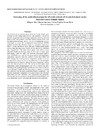Identificador persistente para citar o vincular este elemento:
https://accedacris.ulpgc.es/jspui/handle/10553/47058
| Título: | Screening of the antioxidant properties of crude extracts of six selected plant species from the Canary Islands (Spain) | Autores/as: | Rico, Milagros Sánchez, Idayra Trujillo, Cristina Pérez, Norma |
Clasificación UNESCO: | 230690 Química de productos naturales orgánicos | Palabras clave: | Antioxidants Reducing capacity Radical-scavenging activity (RSA) Plant extracts Biological-Activities, et al. |
Fecha de publicación: | 2013 | Editor/a: | 1613-9216 | Publicación seriada: | Journal of Applied Botany and Food Quality | Resumen: | The extracts of six common plants from the Canary Islands were screened for their antioxidant activities and compared with several phenolic compounds of natural origin (quercetin, catechin, rutin and gentisic acid) and synthetic (butylated hydroxyanisole (BHA) and butylated hydroxytoluene (BHT)). The in vitro antioxidant activity determined by using the 1,1-diphenyl-2-picrylhydrazyl (DPPH) method revealed that Plantago major L., Artemisia canariensis (Bess.) Lessing and Bidens aurea (Dryand.) Sherff exerted greater activity than the other plants (90.9%, 89.0% and 88.2% inhibition rate, respectively). The most active plants were Bidens aurea (Dryand.) Sherff and Plantago major L. (9.5 and 7.2 trolox μmol equivalents), when the cupric ion reducing antioxidant capacity assay (CUPRAC) was used. All the plants species exhibited higher antioxidant capacities than the synthetic antioxidants BHA and BHT. Among the natural phenolic compounds, gentisic acid was the most active. However, two of the plant extracts showed higher antioxidant activity than any other of the pure compounds studied, even than that of gentisic acid. The use of reversed phase high performance liquid chromatography (RP-HPLC) allowed the identification of the natural phenolic constituents listed above in Bidens aurea (Dryand.) Sherff and Plantago major L. extracts. Catechin and quercetin were the most prominent phenolic compounds. The presence of phenolic compounds in the plant extracts and their high antioxidant activities underline their phytomedicinal potentials. These plants may be exploited in the production of health foods and as an antioxidant carrier in the food and pharmaceutical industries. | URI: | https://accedacris.ulpgc.es/handle/10553/47058 | ISSN: | 1613-9216 | DOI: | 10.5073/JABFQ.2013.086.030 | Fuente: | Journal of Applied Botany and Food Quality [ISSN 1613-9216], v. 86, p. 217-220 |
| Colección: | Artículos |
Citas SCOPUSTM
5
actualizado el 08-jun-2025
Citas de WEB OF SCIENCETM
Citations
2
actualizado el 08-jun-2025
Visitas
210
actualizado el 31-oct-2024
Descargas
263
actualizado el 31-oct-2024
Google ScholarTM
Verifica
Altmetric
Comparte
Exporta metadatos
Los elementos en ULPGC accedaCRIS están protegidos por derechos de autor con todos los derechos reservados, a menos que se indique lo contrario.
